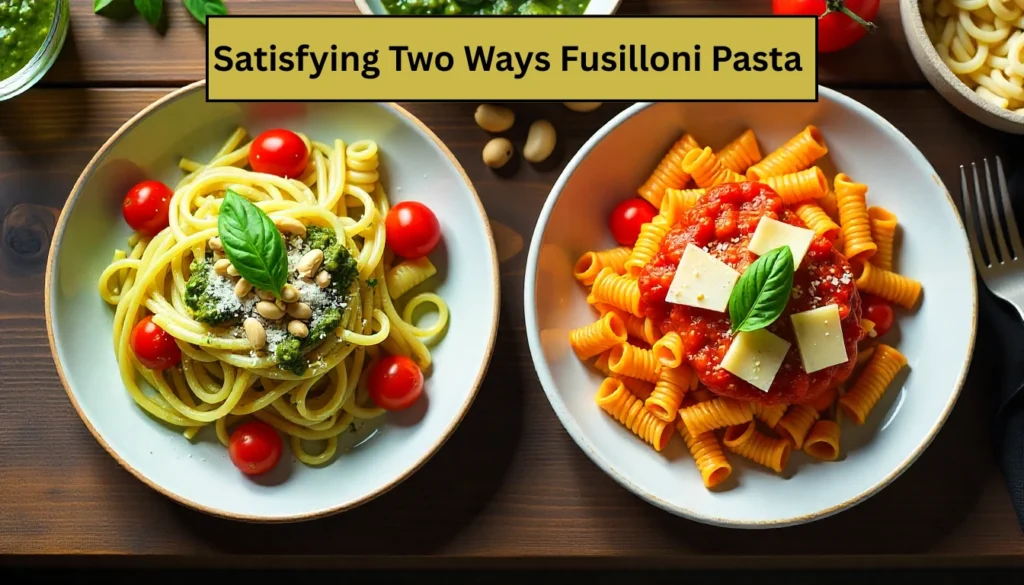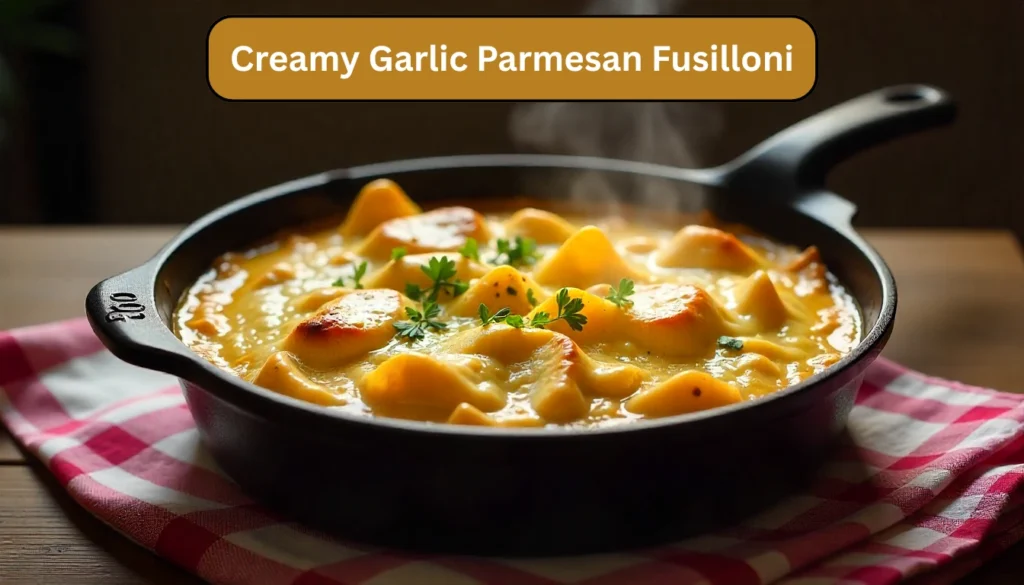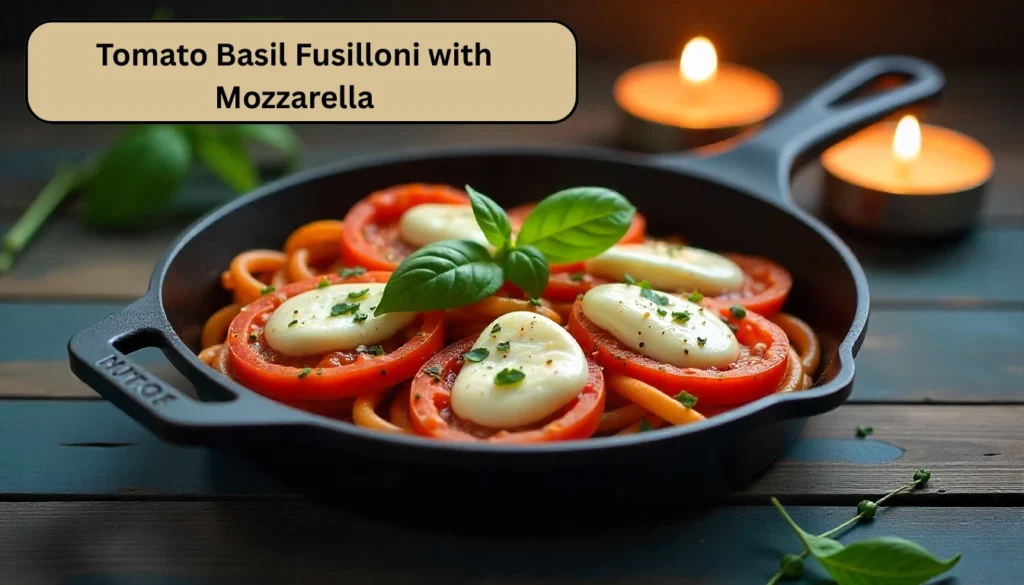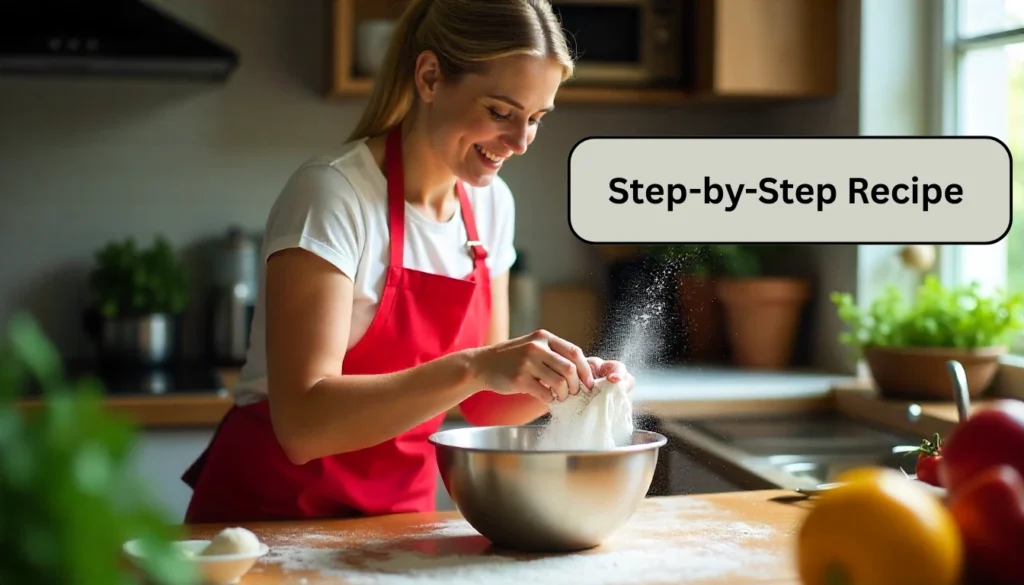
If you’re a pasta lover searching for something rich, comforting, and versatile, you’re in the right place. Today, we’ll dive into Satisfying Two Ways Fusilloni Pasta, where you’ll learn how to make this unique pasta in two delicious versions: one creamy and cheesy, the other fresh and tomato-based.
In this article, I’ll guide you step by step through two recipes, share expert tips from my personal kitchen experience, and also give you serving ideas, storage solutions, and nutritional insights. By the end, you’ll know exactly how to master Fusilloni pasta at home.
What is Fusilloni Pasta?
Before cooking, let’s first understand what makes Fusilloni pasta so special.
Fusilloni is like the “big brother” of fusilli. While fusilli has small tight spirals, Fusilloni comes in much larger, bolder spirals. The advantage? The grooves catch and hold onto sauces—whether thick creamy cheese or light tomato-based ones.
Unlike penne or spaghetti, Fusilloni feels hearty and satisfying, perfect for baked dishes, cheesy casseroles, or flavorful salads. I’ve often found that when I serve Fusilloni, my guests are impressed because it feels a little more “gourmet” than everyday pasta.
Tools & pantry items you’ll need
Before cooking, gather:
- Large pot (6–8 quart) for boiling pasta
- Large heavy skillet or sauté pan (at least 12 in / 30 cm)
- Wooden spoon and silicone spatula
- Fine grater (for fresh Parmesan)
- Chef’s knife and cutting board
- Colander or spider strainer
- Measuring cups & spoons
- Small bowl or jar to whisk dressing (for small additions)
- Kitchen thermometer (optional)
- Tongs for tossing
Having these ready prevents interruptions and keeps timing accurate.
Ingredients (exact amounts for 4 servings)
Recipe A — Creamy Garlic Parmesan Fusilloni

- Fusilloni pasta — 400 g (about 14 oz)
- Water for boiling — about 4–5 L (enough to boil freely)
- Kosher salt — 1 tablespoon for the pot (roughly 17 g)
- Extra-virgin olive oil — 1 tbsp
- Unsalted butter — 2 tbsp (30 g)
- Garlic — 3 large cloves, minced (about 1.5 tbsp)
- Heavy cream — 1 cup (240 ml)
- Freshly grated Parmesan — 1¼ cup (about 100–120 g)
- Freshly cracked black pepper — to taste (start with ½ tsp)
- Fresh parsley, chopped — 2 tbsp for garnish
- Optional: lemon zest — ½ tsp (brightens richness)
Recipe B — Tomato Basil Fusilloni with Mozzarella

- Fusilloni pasta — 400 g (14 oz)
- Kosher salt — 1 tbsp for pot
- Extra-virgin olive oil — 3 tbsp (for sauce + finishing)
- Garlic — 3 cloves, minced
- Yellow onion — ½ medium, finely chopped
- Cherry tomatoes — 400 g (about 3 cups), halved (or 2 large tomatoes diced)
- Fresh basil — 1 cup loosely packed, torn
- Fresh mozzarella pearls — 1–1¼ cups (mini bocconcini), drained
- Red pepper flakes — optional ¼ tsp
- Salt & pepper — to taste
- Optional: Balsamic glaze or a splash of good balsamic — 1 tsp for depth
Before you cook — mise en place (do this first)
Do these prep steps. They save time and prevent mistakes:
- Measure all ingredients into small bowls. Grate the cheese, chop garlic, onion, and parsley, halve tomatoes, and tear basil.
- Bring your large pot of water to a vigorous boil. Add salt only when water is boiling—it dissolves better and seasons the pasta properly.
- Preheat your largest skillet on medium so it’s ready when pasta is done (especially important for the creamy sauce).
I always do mise en place. Once I started prepping everything first, my pasta timing went from “close” to “perfect” — no overcooked noodles and no frantic chasing for utensils.
Step-by-Step: Recipe A — Creamy Garlic Parmesan Fusilloni

This section explains every single action. Read fully before starting and follow in sequence.
1. Start water for pasta
- Fill the pot with 4–5 L cold water. Place on high heat and bring to a rolling boil.
- When water is boiling, add 1 tablespoon kosher salt. The water should taste like the sea — this is your only chance to season the pasta from inside.
2. Cook pasta to al dente
- Add 400 g fusilloni. Stir immediately to prevent sticking (use a long-handled spoon).
- Cook according to the package minus 1 minute — fusilloni often 11–13 minutes, so test at minute 10. Use the “bite test”: pasta should be tender with slight resistance in the center (not chalky).
- Reserve ½ cup (120 ml) of pasta cooking water before draining. Why? Starchy water helps emulsify and loosen sauces later. I never skip this.
3. Drain & set aside
- Drain quickly in a colander. Don’t rinse for the creamy version — rinsing removes surface starch that helps sauce cling.
- Return the drained pasta to the pot off the heat while you finish the sauce, keeping it warm.
4. Make the sauce (while pasta cooks or right after)
- Place the skillet on medium heat. Add 1 tbsp olive oil + 2 tbsp butter. Let butter melt completely but don’t brown.
- Add minced garlic and sauté 30–45 seconds until fragrant — never let garlic darken (it tastes bitter).
- Pour in 1 cup heavy cream and lower heat to medium-low. Let it come to a gentle simmer (small bubbles at edges). Simmer 3–4 minutes to slightly reduce and thicken. Stir frequently.
- Lower heat to low. Gradually add 1¼ cup grated Parmesan in small handfuls, stirring constantly until melted and silky. If cheese clumps, reduce heat and stir; do not boil.
- Taste and season with salt & freshly cracked black pepper. Add a tiny pinch of nutmeg if you like warmer notes (optional).
5. Emulsify sauce with pasta water
- If the sauce feels too thick, add 1–2 tbsp reserved pasta water, whisking to loosen. Keep adding 1 tbsp at a time until you reach a coat-the-pasta consistency. Aim for a glossy, clingy sauce — not watery.
6. Combine pasta & sauce
- Add cooked fusilloni to the skillet and toss gently with tongs or a spatula until each spiral is coated. Work quickly but gently to avoid crushing pasta.
- If sauce thickens while tossing, add another splash of pasta water. The starch helps the cream and cheese bind to the pasta.
7. Final touches & plating
- Remove from heat. Add a light zest of lemon (optional) and fold in half the chopped parsley.
- Plate immediately and garnish with the remaining parsley and extra Parmesan. Serve hot.
Troubleshooting: If sauce breaks (oil separates) — take the pan off heat, whisk in a tablespoon of cold water and a small spoon of grated cheese slowly to bring it back together.
Personal note: I learned to add lemon zest after a friend’s suggestion — it cuts richness and brightens the dish. Try it and see if you like the lift.
Step-by-Step: Recipe B — Tomato Basil Fusilloni with Mozzarella
Again, do these steps in order for the best texture and flavor.
1. Boil pasta (same as Recipe A)
- Bring 4–5 L water to boil, salt it, add fusilloni, and cook to al dente. Reserve ½ cup pasta water. Drain and set aside in the pot.
2. Make tomato-basil sauce
- Heat a large skillet over medium. Add 2–3 tbsp olive oil.
- Add chopped onion; sauté 3–4 minutes until translucent, stirring occasionally.
- Add minced garlic and sauté 30–45 seconds (do not brown).
- Add halved cherry tomatoes (or diced ripe tomatoes). Cook on medium-high until they start to break down (6–8 minutes). Stir and press with spatula to release juices.
- If tomatoes are very acidic, add a small pinch of sugar (¼ tsp) to balance. Optional: add 1 tsp balsamic for depth.
- Add torn basil leaves and stir. Season with salt and pepper, and red pepper flakes if using.
3. Finish sauce and combine
- Turn heat to low. Add reserved pasta water a splash at a time until sauce has loosened enough to coat pasta (you want a saucy, not soupy, finish).
- Add drained fusilloni to pan and toss gently until blooms of sauce are packed into the spirals.
4. Add mozzarella
- Remove the pan from heat. Immediately fold in mozzarella pearls. The residual heat will soften them without making the dish greasy.
- If you prefer melted mozzarella, pop the whole pan under a hot broiler for 1–2 minutes—watch closely—or plate and let cheese melt naturally.
5. Serve
- Garnish with extra basil and a drizzle of good olive oil. A light grind of black pepper on top finishes it nicely.
Personal note: I sometimes roast half the tomatoes for 20 minutes at 200°C (400°F) with olive oil and salt first — that adds a smoky sweetness which I love. It’s a little extra time but worth it when you want depth.
For further guidance, you can also watch this cooking video: Fusilloni Pasta Recipe Video.
Expert techniques & fine points (don’t skip these)
These are small actions that make a big difference:
- Salt the water properly. Use roughly 1 tbsp kosher salt per 4–5 L water. This seasons the pasta internally.
- Test early for al dente. Bite into one piece; you should feel a tiny white center. Pasta continues to soften after draining.
- Reserve pasta water. Always save at least ½ cup. It contains starch that builds the sauce body and helps emulsify oils/cheese into a silky coating.
- Low & slow for cheese. Heat low when adding cheese to avoid grainy texture. Freshly grated cheese melts better than pre-shredded.
- Avoid overheating cream. If cream boils rapidly it can separate — keep to gentle simmer.
- Finish off-heat for mozzarella. Add fresh cheese off the heat so it softens but doesn’t become oily.
- Use good olive oil. For finishing and in sauces — it shows.
- Don’t over-dress. Sauce should coat — not drown — the pasta.
What does Fusilloni go with? (pairings & serving ideas)
Fusilloni is flexible. Pairings I recommend:
- Proteins: grilled chicken, lemon-garlic shrimp, pan-seared salmon, Italian sausage.
- Sides: crusty garlic bread, simple arugula salad with lemon vinaigrette, roasted seasonal vegetables.
- Drinks: creamy version pairs well with a fuller white (Chardonnay) or light red (Pinot Noir); tomato basil with Sauvignon Blanc or light red.
When hosting, offer both recipes side-by-side. Guests love the contrast.
Make-ahead, storage & reheat — exact steps
Make-ahead:
- Prepare components in advance: cook pasta, cool, and toss very lightly with a tsp olive oil to prevent sticking. Store in an airtight container in the fridge for up to 24 hours. Make sauce fresh the day you serve for the best texture.
Storage:
- Creamy Fusilloni: refrigerate in an airtight container for up to 3 days.
- Tomato Basil Fusilloni: keeps 3–4 days refrigerated; better for freezing.
Freezing:
- Tomato version: cool completely, place in freezer-safe containers, freeze up to 2 months.
- Creamy version: not recommended for freezing (cream may separate).
Reheating — stovetop method (best):
- Place leftovers in a skillet on low heat.
- Add 2–3 tbsp water, milk, or additional cream (for creamy) and heat, stirring gently until loosened and warmed through (about 5–7 minutes).
- For tomato, add a splash of olive oil while reheating.
Microwave method (faster):
- Place pasta in a microwave-safe bowl, add a splash of water/olive oil, cover loosely, heat 60–90 seconds, stir, then continue in 30-second bursts until warm.
Nutritional facts (approximate per serving)
Estimates per serving (1 of 4) — values vary by exact brands and amounts:
| Recipe | Calories | Carbs | Protein | Fat | Sodium | Vitamins |
| Creamy Garlic Parmesan Fusilloni | ~540 kcal | ~60 g | ~18 g | ~24 g | Moderate–High (depends on salt/cheese) | — |
| Tomato Basil Fusilloni w/ Mozzarella | ~430 kcal | ~58 g | ~16 g | ~12–15 g | Moderate | Vitamin C (tomatoes), Vitamin K (basil) |
These are general estimates; use a nutrition calculator with your exact ingredients for precision.
Variations & customizations (ideas to try)
- Add protein: Stir in shredded rotisserie chicken into the creamy sauce at the end.
- Roasted veg version: Roast eggplant, zucchini, and peppers; fold into tomato pasta.
- Spicy fusilloni: Sauté chili oil with garlic for a spicy base.
- Vegan swap: Use full-fat coconut or cashew cream and nutritional yeast instead of parmesan; use vegan mozzarella.
- Baked fusilloni: Transfer combined pasta to a baking dish, top with extra cheese and breadcrumbs, bake 12–15 minutes at 200°C (400°F).
FAQs About Satisfying Two Ways Fusilloni Pasta
Q: Can I use regular fusilli or penne?
A: Yes — fusilli captures sauce similarly. Penne works but gives a slightly different bite.
Q: How long does fusilloni take to cook?
A: Typically 11–14 minutes; always check package instructions and do a bite test.
Q: Why did my creamy sauce get grainy?
A: Usually because cheese was added at too-high heat or pre-shredded cheese with anti-caking agents was used. Reduce heat and add cheese slowly.
Q: Can I make the sauce dairy-free?
A: Yes — use cashew cream or full-fat coconut cream and a vegan cheese alternative.
Q: Best way to serve when hosting?
A: Keep pans on warm stovetop or chafing dishes for buffet style; garnish fresh basil/parsley just before serving to keep herbs bright.
Conclusion
We’ve explored Satisfying Two Ways Fusilloni Pasta—one creamy garlic parmesan, and one tomato basil with mozzarella. Both bring out the best of Fusilloni’s spiral shape and sauce-holding texture.
Whether you want something indulgent and rich or fresh and light, Fusilloni pasta delivers a satisfying meal every time. Try both versions, customize them to your taste, and don’t forget to experiment with your own twists.
